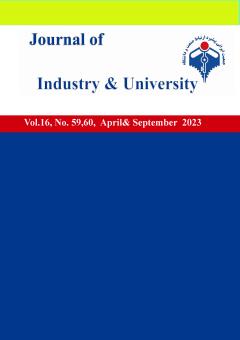Providing a Framework For The Adoption of Cloud Computing Technology
Subject Areas : Special
elham zeynaloo
1
![]() ,
Mahmood Mohammadi
2
*
,
Mahmood Mohammadi
2
*
![]() ,
حسن مهرمنش
3
,
حسن مهرمنش
3
![]()
1 - Department of Technology Management, Central Tehran Branch, Islamic Azad University, Tehran, Iran
2 - Department of Industrial Management, Central Tehran Branch, Islamic Azad University, Tehran, Iran
3 - Department of Industrial Management, Central Tehran Branch, Islamic Azad University, Tehran,
Keywords: Absorption of Technology, Cloud Computing, Bank,
Abstract :
Today, cloud computing technology is expanding and improving, and more services are added to this technology day by day. The aim of the present research is to provide a framework for the absorption of cloud computing based technology. The current research is a developmental-applicative goal and in terms of the research method, it is an exploratory mixed method. The statistical samples of the research were selected from managers, experts and professors in the field of technology management of Tehran universities for in-depth interviews. In this research, the researcher collected the required data by conducting in-depth and semi-structured interviews with 15 members of the community. After conducting a comprehensive analysis of the data, a total of 19 main components (macro category) and 77 sub-components (sub-category) and according to the paradigm model of foundation data theory by following a systematic approach in the form of causal conditions, the main phenomenon central), strategies, background conditions, intervening (intermediary) conditions, and consequences were presented and summarized by the researcher, and all the resulting macro categories were presented and summarized in the form of the table below. The findings of the research showed that "technology absorption" as a central category based on the causal conditions "organizational structure, attention to transparency, behavioral factors, intellectual property, innovation cycle and empowerment" and through response strategies, information transfer, Technology leadership, information security management and target selection are achieved by considering (as a model field) and lead to the realization of the consequences of organizational productivity, improvement of service quality and client satisfaction
1. حق روستا، مجید. تاثیر پذیرش فناوری بر عملکرد کارکنان بانک اقتصادنوین، دانشگاه آزاد اسلامی واحد تهران مرکزی، دانشکده مدیریت و حسابداری، 1395.
2. رحمانیان، سعید؛ نصر، مهدی. ایجاد ظرفیت جذب براي ساماندهی نوآوریهای باز د SME¬ها، چهارمین اجلاس ملی مدیریت فنّاوری ایران، 1391.
3. Camisón C, Forés B. Knowledge absorptive capacity: new insights for its conceptualization and measurement. J Bus Res;63(7): 2010,707–15.
4. De Mattos, C. A., & Laurindo, F. J. B. Information technology adoption and assimilation: Focus on the suppliers portal. Computers in Industry, 85, 2017, 48-57.
5. Hitomi, K. Manufacturing Systems Engineering: A Unified Approach to Manufacturing Technology, Production Management and Industrial Economics. Routledge, 2017.
6. Juels, A., Oprea, A., & Bowers, K. D. Security Issues for Cloud Computing [3]. Meta, 4(5) 2017.
7. LIU, W., & XING, J. Impacts of Renewable Energy Technology Absorption Capacity on Energy Industry Performance in China. Chinese Journal of Management,1, 018, 2017.
8. Martínez-Román, J. A., & Romero, I. Determinants of innovativeness in SMEs: disentangling core innovation and technology adoption capabilities. Review of Managerial Science, 11(3), 2017, 543-569.
9. Mowery DC, Oxley JE. Inward technology transfer and competitiveness: the role of national innovation systems. Camb J Econ;19: 1995, 67–93.
10. Murad Ali, Kichan Park and Françoise Chevalier . “ A Study on the Process Model of Knowledge Absorptive Capacity for Technological Innovation Capabilties: The Case of Samsung Electronics, 2010
11. Omar, R. Takim, R. Abdul, H. & Nawawi . “The Concept of Absorptive Capacity in Technology Transfer (TT) Projects” International Conference on Intelligent Building and Management Proc. of CSIT, IACSIT Press, Singapore, 2011, Vol.5.
12. Omar, R. Takim, R. Abdul, H. & Nawawi . “The Concept of Absorptive Capacity in Technology Transfer (TT) Projects” International Conference on Intelligent Building and Management Proc. of CSIT, IACSIT Press, Singapore, 2011, Vol.5.
13. Rajkumar Buyya, Rajiv Ranjan and Rodrigo N.Calheiros, “Modeling and Simulation of Scalable Cloud Computing Environments and the CloudSim Toolkit:Challenges and Opportunities”, 2009, 978-1-4244-4907-1/09, IEEE.
14. Roshartini Omar 1, Roshana Takim 2 and Abdul Hadi Nawawi 3, “The Concept of Absorptive Capacity in Technology Transfer (TT) ProjectsMalaysia”, International Conference on Intelligent Building and ManagementProc.of CSIT vol.5 (2011) © (2011) IACSIT Press, Singapore.
15. Shalley, C. E., & Gilson, L. L. Creativity and the management of technology: Balancing creativity and standardization. Production and Operations Management, 26(4), 2017, 605-616.
16. Stock, G. N, N. P. Greis & W. A. Fischer . “Absorptive Capacity and New Product Development”; The Journal of High Technology Management Research, Vol. 12, 2001, pp. 77-91.
17. Tâm, T. M. Technology absorption capability evaluation of small and medium enterprises in Vietnam: Conditions from the State and Enterprises. European science review, 2017, (3-4).
18. Todorova, G. and Durisin, B. Absorptive capacity: valuing a reconceptualization. Academy of Management Review,32, 3, 2007, 774–786.
19. Usui, A., Domínguez, J. M., Suzuki, T., Altomare, C., & Tagliafierro, B. Applicability of source generation (SG) and absorption technology in a highly reflective condition. In 12th Spheric Workshop , 2017 ,(pp. 113-120).
20. xiadong Deng, William j.Dell,Mie Cao ,Exploring the absorptive capacity to innovation/productivity link for”, 2007. 21. Xie Yongping, Mao Yanzheng,Zhang Hamiao . “ Analysis of Influence of Network Structure,Knowledge Stock and Absorptive Capacity on Network Innovation Achivements, 2011.
22. Yang, Y., Hong, J., Song, G., & Hong, S. Technology policy, technology strategy and innovation performance: evidence from Chinese aircraft and spacecraft manufacturing. Science and Public Policy,44(5), 2017, 620-630.

